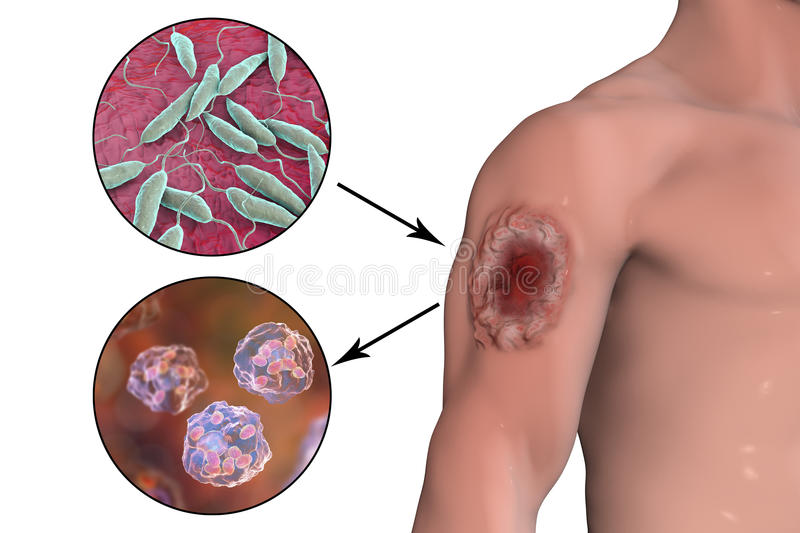What is leishmaniasis and its Transmission Chain?

The WHO estimates that about three million people suffer from leishmaniasis. Learn about the consequences and treatment of this infectious disease that can affect the skin and mucosa, or the marrow, liver, and spleen.
Leishmaniasis is an infectious disease caused by protozoan parasites flagellate the genus Leishmania that can affect the skin and mucous membranes or tissues and organs hematopoietic (the formation of blood cells) such as bone marrow, liver, and spleen. It is transmitted to humans through the bite of infected hematophagous (blood-feeding) Diptera insects, mainly of the genera Phlebotomus and Lutzomya.
There are several variants of leishmaniasis, the three main beings:
- The visceral or kala-azar (it is the most serious type, fatal in almost all cases if not treated properly). Each year there are between 50,000 and 90,000 cases, according to WHO data.
- Cutaneous leishmaniasis (it is the most usual cause of ulcers, visible scars, and causes disability). Each year there are between 600,000 and a million new cases.
- The mucocutaneous leishmaniasis (destroys mucous membranes of the nose, mouth, and throat). Almost all the cases are registered in Brazil, Bolivia, Peru, and Ethiopia.
The treatment of leishmaniasis depends on the type of affectation, the parasite species that transmitted it, and the geographical location of the infection. It is a curable disease, but drugs alone do not eliminate the parasite from the body. Hence you need a strong immune system to fight it.
Prevalence and distribution of leishmaniasis
The World Health Organization (WHO) estimates that about three million people worldwide suffer from the disease, 12 million are infected, and 350 million live in areas at risk of contracting it.
This parasitic disease especially affects the poorest regions of the planet since its appearance is associated with poor food and housing conditions, migratory movements, lack of resources, and, in general, health problems that weaken the immune system. Some experts also link it to climate change or deforestation, as far as the human hand is concerned.
In the Old World, it is endemic in Asia Minor, Southeast Asia, the Mediterranean coast, the Sub-Saharan savannah, and the mountainous areas of Ethiopia, Kenya, and Namibia; while in the New World, it is observed in practically all tropical American countries, in particular: Mexico, Guatemala, El Salvador, Honduras, Nicaragua, Costa Rica, Panama, Venezuela, Brazil, Peru, Colombia, Ecuador, Bolivia, and the Dominican Republic.
Leishmaniasis transmission chain
Before knowing how it is transmitted, it is good that we clarify some terms related to the protagonists of the transmission process of leishmaniasis :
The infectious agent
The parasite responsible for leishmaniasis is an obligate intracellular protozoan of the endothelial reticulum system belonging to the family of kinetoplastids, genus Leishmania, which is made up of various species and subspecies. In the Old World, the main complexes of species present are L. major, L. aethiopica, and L. tropica. At the same time, in the New World, there are L. Mexicana, L. amazonensis, L. braziliensis, and L. panamensis.
The parasite occurs in two forms: promastigote and amastigote. The first is free, mobile, has a single flagellum at the anterior end, and is found in the vector, which is why it is the form that infects humans and animals.
The second is oval, immobile, does not have a flagellum, is found in the affected vertebrate reservoir, and is the form that contaminates the vector.
The vector
They are small files of 2 to 5 mm in length known as sandflies (genus Phlebotomus in the Old World and genus Lutzomya in the New World), which live mainly in wooded areas are characterized by having the body densely covered with ash-colored hair. Long legs and whitish wings always tipped erect. Females need blood to feed their eggs and reproduce; they have a very short flight radius, and when placed on the skin in search of food, they make small jumps.
Its maximum biting activity ranges from six in the afternoon to six in the morning the next day, which is why people who live in risk areas should protect themselves from bites during these hours.
The reservoir
The repertoire is the population of living beings that chronically houses the germ of a disease, spreading like an epidemic. Vertebrate mammals are the reservoirs that support the parasite and, therefore, facilitate the vector to become infected from them. These reservoirs are usually variable depending on the location and form of presentation of the disease.
There are wild reservoirs (the monkey, the sloth, the armadillo, the fox, the opossum, and rodents such as rats), domestic (the dog), and even humans themselves can be, but only where there are foci of leishmaniasis anthroponotic.
The susceptible host
It is the person who comes into contact with the causal agent transmitted by the vector. In other words, it is the individual who is bitten by the sandfly inoculating the parasites and, depending on their immunological conditions, may or may not develop the clinical infection.